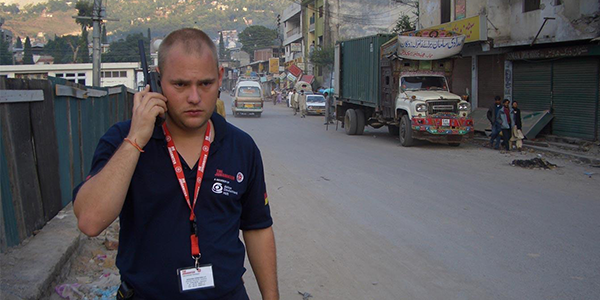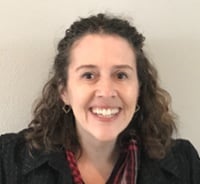Some people discover their passion in life at a young age. Holger Sommer is one of them. Raised in the German village of Henstedt-Ulzburg, Holger followed in his father’s footsteps to join the volunteer firefighters. He was only 13. Though he was too young to respond to calls, he learned how the pumps and valves worked on the fire trucks. When he turned 15, Holger began responding to calls in the community.
Today, Holger is 41 years old. Fittingly, he volunteers as the communications manager at an organization called @fire, a German non-profit that provides rapid emergency aid worldwide after natural disasters.
The organization has a Wildland Firefighting division that fights fires like the recent wildfires in Greece, and also trains fire departments in wildland firefighting. The Urban Search and Rescue division of @fire always has a team on standby that specializes in locating people buried in the rubble, rescuing them, and providing them with medical care.
The majority of the 300 @fire volunteers live in Germany. However, there is also a chapter in Switzerland, where Holger now lives.
“Rescue work is a very tough environment,” Holger says. “Everyone does it as a side job. You have to be very professional, fit, and up-to-date with the procedures. To do all this as a volunteer is difficult.”
As communications manager for @fire, Holger is responsible for the communications strategies used onsite while volunteers are working disasters. Up until recently, the organization mainly relied on VHF radio and satellite communications.
But when @fire recently responded to the massive flooding in its own backyard in Germany, Holger urged the volunteers to use Zello. The consensus was that the push-to-talk app is a breakthrough technology for @fire that enabled Holger to coordinate the most effective organizational response possible.
“How we were able to respond to the flood and the impact we had was one of the most rewarding times in my career,” he says.
And that’s saying a lot, because Holger’s career in disaster response has been incredibly inspiring, as he’s worked missions across the globe during several decades.
War in Kosovo
When Holger was 19, he had just finished school and was weeks away from beginning an apprenticeship at Lufthansa Airlines as a logistics specialist.
He was looking forward to a relaxing vacation before the apprenticeship began, when he got an assignment from Johanniter International Assistance, a humanitarian organization based in Germany. They needed him to travel to war-torn Kosovo immediately.
“We went in a military convoy from Macedonia,” Holger explains. “We had tanks in front of and behind us. The soldiers were fully equipped and we’re in T-shirts. There were mass graves and minefields to the left and right of us as we headed down the road. I was on a humanitarian mission to deliver food, water, and other relief goods to the affected population.”
It was July 1999, one month after NATO went into Kosovo and began its 78-day air campaign. Holger was supposed to deliver the relief and head back to Macedonia the next day. The problem was that after the Johanniter trucks delivered the aid to people in Kosovo, one of them broke down.
Someone had to stay with the truck and try to get it fixed—and that task fell to Holger..
So he remained behind in Kosovo, arranging the repair of the truck.
“I loved the challenge of working in a new environment and trying to get things organized,” he says.
A few days later the truck was in the workshop so Holger could head home to start his apprenticeship.
By the time he arrived back in Germany, Holger was hooked on humanitarian work. Over the coming decade, he would complete many more missions as part of Johanniter International Assistance. Through each one, Holger gained critical insights and honed his expertise.
Earthquake in Iran
On December 26, 2003 a 6.7 magnitude earthquake struck Bam, Iran. Holger and the Johanniter team arrived in Bam three days later to deliver WHO new emergency health kits that would provide basic healthcare to 10,000 people for three months and conduct a needs assessment at the hospitals.
The city of Bam in Southeastern Iran was built out of sand bricks.
Holger says, “When we arrived onsite it looked like smashed beach sandcastles everywhere.”
In the end, the death toll would be 26,271 and 30,000 injured.
Holger instantly knew that his team had failed to adequately prepare for the mission. They had planned to partner with other organizations to get accommodations, food, and electricity. As a result, Holger and his colleagues hadn’t brought their own tents to sleep in or their own generators.
It was then Holger vowed to always ensure his team was self-sufficient, bringing all of their own supplies and not relying on anyone else to provide them with the necessities required to successfully execute a life-saving mission.
Floods in Germany
By the time the catastrophic flooding hit Western Europe in July 2021, Holger had decades of mission experience under his belt. He was living in Switzerland and volunteering as the communications manager for @fire. Whether the mission was search and rescue, delivering humanitarian aid, or fighting wildfires, Holger was responsible for coming up with the communications strategy at each particular site.
The vast majority of @fire volunteers are German citizens, so they were responding to a calamity in their own backyard.
“I would have never imagined a catastrophe like this in my home country,” says Holger. “The destruction hit a 50 kilometer region.”
A few days after the floods hit, @fire dispatched two dogs and 85 volunteers for a search and rescue operation. Holger and the team drove to a small village called Rech that is close to the city of Cologne. The town is split by a river that flooded. In normal times, people stroll across the stone bridge and meander through the picturesque village which rests in the valley. It’s surrounded by lush green hills that are dotted with wineries.
After the flood, the devastation was breathtaking. The bridges? Gone. Electrical system? Internet lines? Water? Gone. Cellular system? Heavily damaged. In all, 63 bridges had been destroyed, and 13 had sustained heavy damage.
“There was no infrastructure left,” Holger explains. “Everything had been washed away. Bridges had been washed away and parts of houses lay in the river. Sewage was everywhere and people were trying to save their homes by shoveling the mud out. Since people had food at home that could no longer be cooled, the next big fear was rats.”
In the wake of such extensive damage, Holger called on the lessons he had learned over decades of work in disaster relief.
Transport
The @fire teams had arrived with a few cars, but it wasn’t possible to traverse the steep hills of the wine region with regular vehicles. The ambulances and large fire trucks were too large to navigate the terrain because of the extensive damage, which had washed away most of the streets directly on the river.
Fortunately, Holger and @fire had developed a good relationship with a few German companies that were eager to help.
“It was amazing to see how the private sector supported us,” Holger says. “We picked up all kinds of All-Terrain Vehicles (ATVs) from these companies and brought them to the site. We deployed things like small 4-wheel drive vehicles that are smaller than cars and could go over the wine hills into the villages to transport relief supplies and assess roads and bridges,” he explains.
@fire was able to secure use of a medic ATV that could travel the gravel roads that a regular ambulance couldn’t. The organization equipped the vehicle with paramedics, EMTs, and emergency medical equipment. Using the medic ATV, @fire was able to assist people who were inaccessible to the regular ambulance due to collapsed bridges and flooded roads.
Communications
@fire set up a control center in an empty parking lot next to the Red Cross, fire department, and the German federal department for technical relief, a few kilometers away from the disaster zone. Unfortunately, the fire department’s communication system was no longer in service.
“We tried a traditional VHF radio, but because the terrain was so steep, even with a VHF antenna on a 10 meter pole we could only transmit 3 kilometers which is not a lot,” Holger explains. “The big advantage of Zello is that it requires only a basic data connection and works already with 2G/ GPRS. Often we couldn’t call someone with the cell phone, but Zello worked.”
While many volunteers from @fire used WhatsApp to exchange photos and messages, Holger saw that they needed a more robust technology that would allow for real-time communications.
In the past, when Holger tried to introduce Zello, he faced some resistance.
“Germans aren’t as open to trying new technologies as Americans,” he says. But in this case, Holger insisted that with so many small all-terrain vehicles going off-road in the region, they needed a better way to communicate with them all.
“I told them, ‘Zello is the right solution for this job,’ and then I personally showed them how easy Zello is to use.”
It only took Holger a few minutes to get each disaster relief worker up-to-speed on the app.
“Once they understood it, they were good with it,” Holger says. “A lot of the people told me, ‘We should have been using Zello earlier.”
The @fire Impact
Because @fire had many small all-terrain vehicles on site, and because the drivers could communicate via Zello, they organized the team to map the streets. They created an online map that showed which roads were passable, which bridges were wiped out.
“We generated a QR code. Other organizations could scan the code to see which roads were destroyed and what kinds of vehicles they would need to get across a certain bridge,” Holger says. “We were the first to start this kind of mapping project and it was very effective.”
In addition to the mapping project, @fire contributed in several other ways. Teams conducted search operations in a campyard and in an underground garage, where they pumped out water to search for people who might be trapped in their cars. The organization also operated to provide electricity in the city of Lohmar, and they delivered relief and medical supplies throughout the region.
In the end, at least 180 Germans were killed in the historic floods. But Holger and the @fire team had a significant contribution to helping with the rescue efforts.
Weeks after Holger returned home to Switzerland, @fire continued to help the region, delivering 12 tons of relief goods (valued at 100k Euros) to the village of Mayschoss.
“It was rewarding to successfully introduce new communication technology to a complex disaster like this and optimize relief work,” says Holger.
To learn more about Holger and @fire and the great work they do, visit their website and follow them on Facebook, LinkedIn, and Instagram, and check out their Facebook group for Zello first responders.

